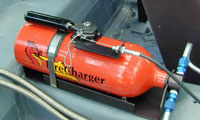Congratulations on your purchase of a new Fire Suppression System! (If you're still trying to choose a system, take a look at our page on Choosing and Using a Fire Suppression System.) Follow along to find out what to expect and how to keep your new system ready to protect you. |
Installation review
First, let's review a few of the most important highlights about installation.
Follow the manufacturer's installation instructions (failure to do this will void any certifications).
Use all of the nozzles provided in the kit (adding or subtracting nozzles will void any certifications).
Position the nozzles per the manufacturer's instructions.
If the manufacturer's instructions do not specify nozzle location, follow your rulebook guidelines.
If your rulebook does not specify nozzle location, install at least half of the nozzles in the cockpit to protect the driver. Install the remaining nozzles so that they cover any likely sources of ignition (turbo, exhaust header, etc).
After installation
Just like any other critical part of a racecar, the fire suppression system requires periodic inspection and maintenance. It is a piece of safety equipment, so don't neglect it!
Before every track session: Test the battery and arm the system (electrical systems). Remove all safety pins from actuating mechanism (mechanical systems).
After every track session: Disarm the system (electrical systems). Reinstall at least one safety pin in the actuating mechanism (mechanical systems).
Before and after every race weekend or test day (in addition to the every-session checks): Check the wiring (electrical systems). Disconnect and check actuator cable for smooth operation (mechanical systems). Check that the pressure gauge needle is in the green area (pressurized systems). Check the service due date (SFI and FIA systems). Check the discharge lines for kinks and cracks. Check that all nozzles are still present and clean.
Before and after every season (in addition to the every-session and every-event checks): Disconnect discharge lines from bottle and clean out any debris. Remove bottle and examine for damage. Weigh bottle to ensure it is full. Store bottle in a dry area at a stable temperature. (That means bringing the bottle inside your house for the winter, especially if temperatures are expected to dip below freezing. AFFF in particular will freeze if it gets too cold, which can cause the bottle to burst.)
If the system fails ANY of these tests, do NOT race with it until the problem has been corrected! You will be putting your safety at risk.
Service Due Date and Recertification
| Note: We no longer sell or service AFFF fire bottles. Any AFFF bottle sent to us for service will be returned and return shipping charges will be billed. |
SFI and FIA both require fire bottles to be recertified every 2 years. The recertification must be performed by the manufacturer or their authorized representative. This can take a few days (plus travel time back and forth). It is important to plan for this downtime, and to incorporate it into your racing schedule.
Pegasus Auto Racing Supplies is a factory-authorized service center for SPA and Lifeline Novec and FK-5-1-12 fire systems. All other brands and types must be sent directly to the manufacturer for service.
Bottles that are past their mandatory service date cannot be recertified or refilled. This doesn't mean that a bottle that expires on Monday has to be discarded on Tuesday, but it does mean that if you ignore the mandatory recertification schedule, we can't help you.
Total service life from the date of installation is currently limited to 6 years for SFI systems and 10 years for FIA systems (assuming timely recertifications). When the bottle reaches the end of its service life, you will need to buy a replacement bottle.
Manufacturers recommend the same 2-year service interval / 10-year life span for non-certified systems.
A few more keys to happiness
As Carroll Smith said in Prepare to Win, "[The driver] should be instructed to activate the system when it looks like he is going to hit something hard and not to worry about the cost of refilling it if it turns out it wasn't needed. If he doesn't activate it, and he doesn't happen to be conscious when he needs it, it's too bad."
If you take your racecar to car shows, or if you encourage young racing fans to sit in the car (good for you!), double-disarm the system beforehand. For an electrical system, that means turning off and unplugging the actuator box. For a mechanical system, that means inserting safety pins at the pull cable handle and at the bottle head (or disconnecting the pull cable entirely). Roughly half of the fire bottles we refill come with the same note: "I heard him say, 'What does this red button do?', then whoosh... "
The double-disarming trick is also recommended any time you are working on (in) the car near the actuator. It is very easy to bump the actuator in the tight confines of a racecar cockpit.
If the needle on your pressure gauge is anywhere in the green zone, your system has enough pressure to operate properly. It doesn't matter if it's in the top third or bottom quarter, as long as it's in the green. (If the ends of the green zone were no good, they wouldn't be green!)
The pressure gauge needle will move as the temperature changes. When the bottle is heated, the contents will expand, which will increase pressure. If the needle ends up above the green zone after a race, try adding some insulation to keep the bottle a little cooler next time.
Protect the bottle label(s) from scuffs and scratches. For heaven's sake, do not remove the labels! You will need to refer to those labels many times over the life of the system. If the tech inspector can't read the service date or certification label, the car won't pass. If you can't read the manufacturer name, you won't know where to send it for service. If we can't read the serial number, we can't refill or recertify it. If you can't read the bottle size, you won't know what to order next time. A piece of clear packing tape over the label will help. Rotating the bottle so the label is protected (yet visible, even if you have to use a mirror) will help even more.


